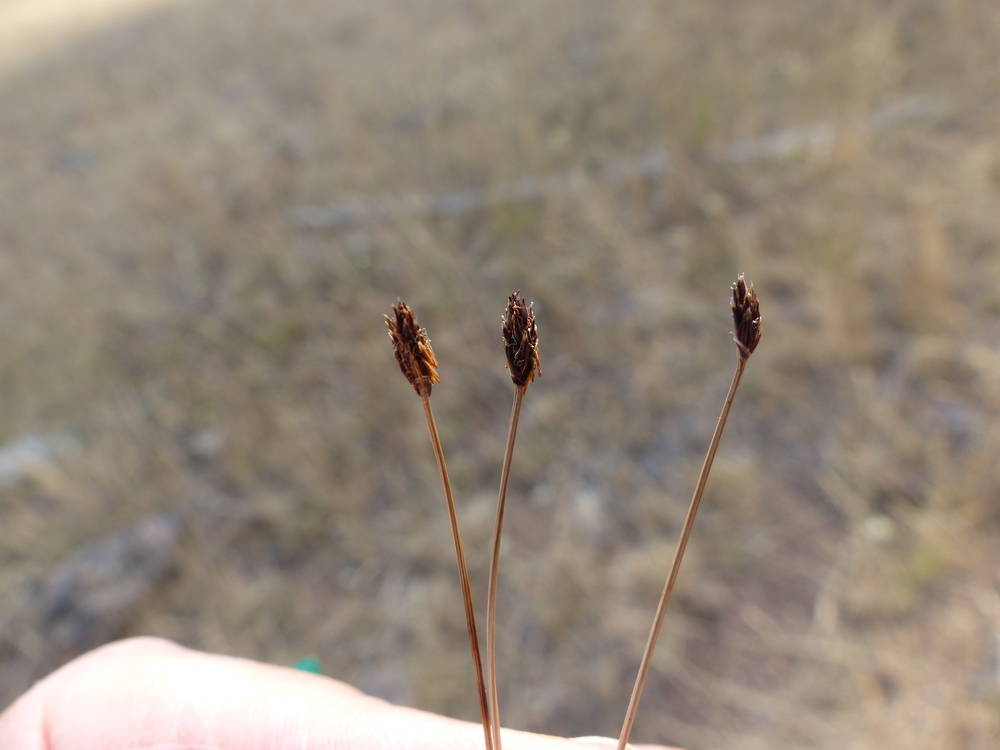Eleocharis bolanderi
Eleocharis rostellata
Bolander's spikerush
walking sedge, walking spikerush
subterete, 10–30 cm × 0.3–0.5 mm.
1.5–3 times as wide as thick, 20–100 cm × 0.35–2 mm; wiry; some culms arching or decumbent and rooting at tips.
ovoid, 3–8 × 2–3 mm;
proximal scale clasping; entire, subproximal scale with flower; floral scales 8–30, 4–5 per mm of rachilla, 2–3 × 1.5 mm;
apex entire; acute, often keeled in distal part of spike.
5–17 × 2.5–5 mm;
spikes on stolons rudimentary and sometimes producing bulbs;
proximal scale empty; amplexicaul, 2–4 mm, subproximal scale with flower; floral scales 20–40, 2–3 per mm of rachilla, 3.5–6 × 2–3 mm;
apex entire, rounded to subacute.
perianth bristles 3–6, often unequal; from rudimentary to 50% of achene length;
anthers 0.9–1.4 mm;
stigmas 3.
perianth bristles, equaling achene or tubercle;
anthers 2–2.4 mm;
stigmas 3.
slightly to greatly compressed-trigonous, rarely thickly lenticular, 0.9–1.2 × 0.65–0.8 mm.
often very variable within one plant, 1.5–2.5 × 1–1.2 mm;
beak to 1 × 0.6 mm.
persistent, not splitting;
apex obtuse, rarely hardened, lacking a tooth.
not splitting;
apex usually reddish.
flat to shallowly pyramidal; lower than wide, 0.1–0.3 × 0.4–0.65 mm.
when present pyramidal; to 0.5 × 0.3 mm.
Eleocharis bolanderi
Eleocharis rostellata
Shallow, rocky, ephemeral streams. 1100–2100 m. BR, BW, Owy. CA, NV, ID; east to CO. Native.
Eleocharis bolanderi is easily recognized in summer when it forms masses of dry, brown, dormant and apparently dead culms in dry stream beds. It is easily pulled up to expose its cespitose habit. The virtually flat tubercles are particularly distinctive.
Wet, often alkaline soils on shorelines and around springs and fens. 50–1500 m. BR, Col, ECas, Owy. CA, ID, NV, WA; north to British Columbia, east to New Brunswick, south to Mexico and West Indies. Native.
When not producing stolons, E. rostellata can resemble E. suksdorfiana, but the latter species has a flower in the proximal scale. Eleocharis rostellata can form large pure stands.
Barbara Wilson, Richard Brainerd, Nick Otting
Barbara Wilson, Richard Brainerd, Nick Otting
- Local floras:
CA,
OR,
WA
- Local Web sites:
CalFlora,
CalPhotos,
Flora NW,
PNW Herbaria
WildflowerSearch
iNaturalist (observations)
USDA Plants Database
- LBJ Wildflower Center
- SEINet
- Plants of the World Online
- Encyclopedia of Life
- Wikipedia
- Google Image Search
- Local floras:
BC,
CA,
OR,
WA
- Local Web sites:
CalFlora,
CalPhotos,
Flora NW,
PNW Herbaria
WildflowerSearch
iNaturalist (observations)
USDA Plants Database
- LBJ Wildflower Center
- SEINet
- Plants of the World Online
- Encyclopedia of Life
- Wikipedia
- Google Image Search




